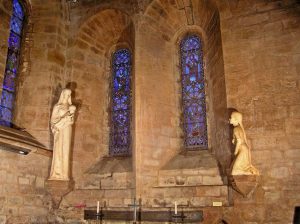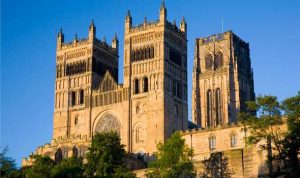An overview of our project, research methods, and sources
The North of England is notable for its high number of celebrated Anglo-Saxon saints, many of them ably documented and memorialised by Bede of Jarrow, in his prose and metrical Lives of St Cuthbert and Ecclesiastical History of the English People. The cults of Aidan, Oswald, Cuthbert, Wilfrid of York, Eata of Hexham, John of Beverley, Hilda of Whitby, Aebbe of Coldingham, Kentigern, Bega, and many others, survived the ravages of the Danish raids, albeit with traumas and dislocations, and continued to be venerated at new foundations after the Norman Conquest, when the saints were frequently retranslated and the cults generated new vitae and miracle collections in order to attract significant pilgrim populations in the twelfth and early thirteenth centuries.

In the twelfth century, their ranks were enlarged by a number of new episcopal, monastic and eremitic saints: William of York, Robert of Knaresborough, Godric of Finchale, Bartholomew of Farne, Aelred of Rievaulx, Robert of Newminster etc., whose exemplary lives were often consciously modelled on the vitae of their Anglo-Saxon predecessors. Thus a conscious tradition of northern sainthood can be traced.
The north of England has a particularly strong tradition of local independence from southern political authority, perhaps most ably exemplified by the County Palatine of Durham, effectively ruled by its Prince Bishops, which retained extensive local privileges vis-a-vis jurisdiction and exemption from central taxation until late in the Middle Ages.

The narratives of validation behind these northern traditions of independence were frequently constructed and maintained with reference to the Anglo-Saxon saints at the centre of local communities, who were depicted as providing their people with land in the first instance, and then later performing miracles to help protect their diocesan territories against external incursion or violation. St Cuthbert offers an excellent case study of this regional priority as it relates to the north of England. From the eighth to tenth centuries, he works miracles designed to protect his lands from incursions by the Danes and Scots, while in the eleventh and twelfth centuries, he chases Norman tax collectors out of his diocesan precincts by cursing them with fever, and saves the city of Durham during periods of ensiegement by Scottish armies.
To what extent do these Anglo-Saxon and early English northern saints’ cults continue to command a local devotional following in the fourteenth and fifteenth centuries? And in this later period, to what extent do they continues to embody a will to independence within the northern counties? In order to answer these questions successfully the following bodies of textual material will be analysed.
Textual and Visual Corpus
- Entries on the northern saints in saints’ legendaries in Latin, Middle English and Anglo-Norman.
Latin Legendaries will include the Sanctilogium angliae of John of Tynemouth, and its derivatives (the Nova legend Anglie and The New Legende of Englande).
Vernacular legendaries will include the North English Legendary, the Scottish Legendary, the South English Legendary, the newly discovered Abbotsford Legendary and the Gilte Legende.
- Individual Lives of the northern saints
Examples include the Latin Lives of St Bega of Cumbria and St John of Beverley (MS Cotton Faustina B IV), and the metrical vernacular Lives of St Cuthbert (MS Egerton 3309) and St Robert of Knaresborough (MS Egerton 3143).
- Fourteenth- and fifteenth-century recopying of earlier Anglo-Saxon and twelfth-century saints’ lives and miracle collections in large-scale monastic compendia, testifying to continuing interest in a cult.
Oxford, Bodleian Library, MS Fairfax 6, and British Library, MS Harley 4843 serve as interesting examples.
- Evidence from visual and material culture
This evidence will include fifteenth-century stained glass programmes at York and Durham, wood panel paintings at Hexham and Carlisle, and late medieval architectural revisions to shrine precincts and pilgrim accommodation. Church dedications, liturgical offices, relic lists, and guilds will also be of interest.
